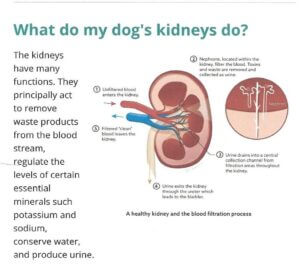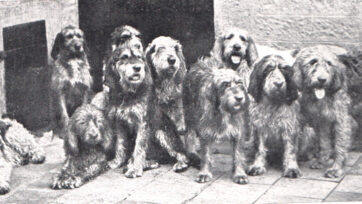
THE ROAD TO A DOG’S KIDNEY DISEASE RECOVERY IS THROUGH THE RIGHT DIET
THE KIDNEY DISEASE DIET
I lost my dog to kidney disease and hope to provide as much information as possible so that you may save yours. My dog’s kidney disease seemed to come out of nowhere and was terminal within a week. But as I’ve researched this disease and others that attack dogs I now realize that there were many signs. There is much research going on in this field toward the slowing or prevention of kidney disease but what I want to cover here is the use of diet in the treatment of this major disease.
THE KIDNEYS AND KIDNEY DISEASE

A dog’s kidney disease diet is a big part of an essential treatment that’s often required for any canine with kidney problems to get better. Always discuss this with your vet and listen to the advice given because every pet is different, and not every homemade kidney diet for dogs will work for your particular dog.
There have been some very specific guidelines and dietary plans made by vets that need to be followed to treat dogs with kidney disease. You can follow these guidelines but to give the most effective kidney disease diet to your dog, first going over any dietary plan with your vet.
The exact amount of food needed for your dog will always depend on the dog and your vet can help determine just that. He can determine the best portion size for the dog knowing its breed, size, age, and stage of the disease. The vet can also help you choose the kidney-friendly dog food brand, or go over your homemade kidney diet for dogs if cooking yourself to see if it’s the right and safe fit for your dog.
We’ll now look at what is considered the general scientific and veterinary consensus on a treatment diet for dogs with kidney disease:
- Reduce phosphorus: Phosphorus is one of the most common minerals in the dog’s body and is essential to many health-related functions. However, it can also stress the dog’s kidneys, and in the case of renal ( kidney ) failure, the stress has to be reduced.
- Less protein: Based on the above, reducing the amount of protein intake will subsequently reduce the amount of phosphorus in the dog’s body.
- Less Salt: Sodium ( salt ) like phosphorus can put extra pressure on the kidneys by forcing them to work harder, therefore including less salt in your dog’s diet is going to relieve some of the work they have to do.
- Omega – 3s are needed: Research has shown that supplementation with omega – 3 fatty acids can help the function of the kidneys, and assist with dog kidney disease in general. This includes feeding foods higher in the omega – 3 fatty acids, or using fish oil dog supplements. A regular dosage can be used as indicated in the supplements directions.
- Calcitriol supplementation: This most likely will be administered by your vet, when needed. The calcitriol is specifically used for patients with kidney problems in both humans and dogs. If your not sure how to use it your vet can help you if it’s needed at all.
Not to be forgotten, dogs with kidney disease should stay in as good a physical condition as possible. Also, relieve stress from digesting food and processing liquids. The best thing to do is to lower the amount of food in a single portion, but increase the number of meals per day ( 4-5 times a day ) if necessary. This will make digestion easier and faster for your dog’s kidneys ( less stress ).
The main dog foods for kidney disease are made with the above science recommended instructions in mind. They will be lower in protein, low in salt, low in calories, and include different supplements and ingredients shown to alleviate the stress on the kidneys. However, commercial food isn’t essential if you know how to make a dog kidney disease diet yourself, following a vet’s recommendations.
Healthy water intake should be encouraged, therefore water should always be accessible to your dog at all times. Use purified or distilled water because tap or well water can sometimes be high in added minerals that can be bad for a dog with kidney disease. Bottled water can also be used, just make sure that your dog is hydrated at all times because dehydration will further complicate the kidney disease problem.
While you may have to reduce the amount of protein it is important that the protein used is high-quality. Meat is always a great place to start, whether raw ( safe ) or cooked/prepared meat for your homemade kidney diet for your dog. Eggs are a good source of high-quality protein but don’t use the yolk because it is very high in phosphorus. Try to always use just egg whites.
Now comes the fat. The amount of fat you use in your dog’s food will depend on his weight and activity level. If he/she is overweight or inactive, stick to moderate fat intake. If the dog is in good shape and really active, you can increase his fat intake because fat is a healthy source of energy ( but high in calories ) and is low in phosphorus.
One thing about fats though, while increasing fat, which contains sources of omega – 3 fatty acids that have been shown to help in kidney disease in dogs, too much fat can be harmful to some pets, especially for their digestive system. An increased amount of fat may cause diarrhea or mucus in stools. Dogs with a predisposition to pancreatitis can’t handle a lot of fat in their kidneys’ diet. If you want to increase your dog’s fat intake, you need to do it gradually and carefully under your vet’s supervision.
ABOUT CARBOHYDRATES
Carbohydrates are not nutritionally necessary for dogs because they get energy from fats and protein, but for dogs with kidney disease, carbs must be included. Research shows and vets recommend that a dog kidney disease diet should have up to 50% of carbs. They’re a good source of calories for dogs with CKD ( chronic kidney disease ) because most foods will be low in phosphorous. These foods will include vegetables and fruits, as well as appropriate grains.
WHAT ABOUT PHOSPHORUS AND CALCIUM
As discussed above, research has shown how low-phosphorus diets can have positive results in slowing down the progression of kidney disease in dogs. Foods high in phosphorus included dairy products, bones, fish with bones, egg yolks, and organ meat ( among others ). When structuring a dog kidney disease diet, these foods should be highly limited or avoided altogether, depending on the stage of the kidney disease.
You should also keep track of phosphorus in grains and vegetables that you are giving your dog. While most carb sources will generally contain low to none of it, some foods still may be a source of phosphorus in your dog’s daily diet.
Calcium is also very important because it acts as a phosphorus binder. Lack of calcium in the dog’s diet will often lead to an excess of phosphorus minerals in the body, which then can cause problems with the kidneys. You can simply add a half a teaspoon of ground eggshell per pound of food in each meal, or use calcium supplements or other calcium-heavy foods. Don’t use bones as a source of calcium because they are high in phosphorus.


